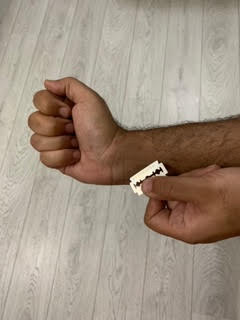Many adolescents today are struggling to cope with extreme levels of stress in school, in their families, in their peer relationships and the pressure caused by instant connectivity (Phone/ WhatsApp/ Instagram/ Facebook et al). Some of these youngsters are overscheduled and being hurried through their adolescent years by their parents and peers alike. Teens have become emotional and vulnerable prey to our highly toxic, media-driven world. These strong emotions may be linked to intense pressure, school or relationship problems, conflictual relationship with and/ between parents, tense atmosphere at home, anxiety or situations that make adolescents feel helpless. Adolescents start to question their own worthiness and are often left feeling that they are not ‘good-enough’ for anything. When individuals are overwhelmed with a painful emotion, sometimes they don't know how to handle it or, at times, they have no outlet; this is when they may self-harm. Self-harm is a process of cutting and causing injuries to oneself.
The physical pain of self-harming is like a release valve to expresses and relieve the emotional pain. Someone may see the releasing of blood similar to releasing the strong feelings they have inside. Others self-harm because they feel numb and the pain of self-harm allows them to feel something. Self-harm also allows a person to express pain when they don't know any other way to express it. The visible self-harming becomes a sign of the pain and a form of communication. The releasing of pain/ feelings/ emotions or numbness is just temporary. So, it is clear that self-harm is primarily a tool (albeit unhealthy) that young people use as a coping mechanism to express themselves and manage their feelings. Sometimes it occurs due to adolescents’ inability to process and share disturbing incidents, thoughts or emotions. Other times it occurs because of a lack of safe spaces to share with their family.
Self-harm is often misunderstood as an attention seeking behaviour. However, what is important to consider is that if an adolescent is self-harming, he/she probably does need an adult’s attention and time because he/she is in pain and wants to talk and be heard in a space that is safe and non-judgemental.
Moreover, if for certain adolescents, living in the real life becomes unbearable, they fantasize suicide for reasons such as:
- To be able to end the pain caused to themselves and their family
- To end the unbearable anguish
- To change the behaviour of others
- To seek help
- To show desperation to others
- To “get back at” other people or make them feel guilty
- To gain relief of tension
- To escape from a situation
Suicide is usually an outlet that an adolescent will only come to after trying everything else, as a last option. Thus, as a parent/ caregiver of an adolescent, it is important for us to be aware of these initial signs so that the issues can be contained at a nascent stage. It can be difficult to identify young people at risk of self-harm, even though many older adolescents who are at risk, consult their general practitioners before they self-harm. Suicidal ideation is relatively common among adolescents; precipitating events may be non-specific; acts of self-harm are often impulsive; and secrecy and denial are common.
Adolescents will always begin by small cuts on their arms or thighs, they might use blades, razors or a compass. At times, these cuts are exposed. Parents must be vigilant, gently approach the situation with a conversation about how they are feeling and how are things with friends etc. If the adolescent feels you are judgemental, blaming or intrusive, they will then start denying or hiding. Effective preventive care requires mental health services and awareness about the same.
Thus, self-harm and suicide are major mental health problems in adolescents. Important contributors to self-harm and suicide include genetic vulnerability and psychiatric, psychological, familial, social, and cultural factors. The effects of media and contagion (copy cat effect – those highlighted by Blue Whale Challenge, The Momo Challenge) are also important, with the internet having an important contemporary role. Prevention of self-harm and suicide needs both universal measures aimed at young people, in general, and targeted initiatives focused on high-risk groups. Restriction of access to means for suicide is important. Major challenges include the development of greater understanding of the factors that contribute to self-harm and suicide in young people, especially mechanisms underlying contagion and the effect of new media.
If you are aware of adolescents exhibiting signs of self-harm, then a combination of individual and family therapy is recommended. Individual therapy provides a space where they can express themselves and understand their own journey till that point. Such therapy helps them understand and develop communication skills to express themselves in a healthy manner and develop healthy coping skills. Through therapy, they also see how and why such adolescents are their own biggest critics. So, therapy provides them a space where they can work through their anger/emotions and develop a healthy and loving image of themselves. A therapist will not judge them for self-harming or tell them to stop harming (they are probably already judging themselves very harshly). Instead, a therapist will help them understand and eradicate the root of the reason they self-harm. Family therapy, on the other hand, is about helping the family and the adolescent to integrate in a way, where both the family and well as the adolescent feel that they are able to accept and communicate their inner feelings. It is a neutral space where everyone can share their feelings and views and once each person feels understood, they are more willing to reach a solution that is best for the family as a unit.



